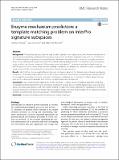Files in this item
Enzyme mechanism prediction : a template matching problem on InterPro signature subspaces
Item metadata
| dc.contributor.author | Mussa, Hamse Yussuf | |
| dc.contributor.author | De Ferrari, Luna | |
| dc.contributor.author | Mitchell, John B. O. | |
| dc.date.accessioned | 2015-12-09T15:10:04Z | |
| dc.date.available | 2015-12-09T15:10:04Z | |
| dc.date.issued | 2015-12-03 | |
| dc.identifier | 235779362 | |
| dc.identifier | 8d8cd412-bc76-4a75-9427-11be9e24bb06 | |
| dc.identifier | 84988836378 | |
| dc.identifier.citation | Mussa , H Y , De Ferrari , L & Mitchell , J B O 2015 , ' Enzyme mechanism prediction : a template matching problem on InterPro signature subspaces ' , BMC Research Notes , vol. 8 , 744 . https://doi.org/10.1186/s13104-015-1730-7 | en |
| dc.identifier.issn | 1756-0500 | |
| dc.identifier.other | ORCID: /0000-0002-0379-6097/work/34033381 | |
| dc.identifier.uri | https://hdl.handle.net/10023/7900 | |
| dc.description | The authors thank the BBSRC for funding this research through grant BB/I00596X/1 and are also grateful to the Scottish Universities Life Sciences Alliance (SULSA) for financial support | en |
| dc.description.abstract | We recently reported that one may be able to predict with high accuracy the chemical mechanism of an enzyme by employing a simple pattern recognition approach: a k Nearest Neighbour rule with k=1 (k1NN) and 321 InterPro sequence signatures as enzyme features. The nearest-neighbour rule is known to be highly sensitive to errors in the training data, in particular when the available training dataset is small. This was the case in our previous study, in which our dataset comprised 248 enzymes annotated against 71 enzymatic mechanism labels from MACiE. In the current study, we have carefully re-analysed our dataset and prediction results to “explain” why a high variance k1NN rule exhibited such remarkable classification performance. We find that enzymes with different chemical mechanism labels in this dataset reside in barely overlapping subspaces in the feature space defined by the 321 features selected. These features contain the appropriate information needed to accurately classify the enzymatic mechanisms rendering our classification problem a basic look-up exercise. This observation dovetails with the low misclassification rate we reported. Our results provide explanations for the “anomaly” – a basic nearest-neighbour algorithm exhibiting remarkable prediction performance for enzymatic mechanism despite the fact that the feature space was large and sparse. Our results also dovetail well with another finding we reported, namely that InterPro signatures are critical for accurate prediction of enzyme mechanism. We also suggest simple rules that might enable one to inductively predict whether a novel enzyme possesses any of our 71 predefined mechanisms. | |
| dc.format.extent | 1066601 | |
| dc.language.iso | eng | |
| dc.relation.ispartof | BMC Research Notes | en |
| dc.subject | Enzyme mechanism | en |
| dc.subject | InterPro signatures | en |
| dc.subject | Nearest-neighbour | en |
| dc.subject | QD Chemistry | en |
| dc.subject | QR Microbiology | en |
| dc.subject | DAS | en |
| dc.subject.lcc | QD | en |
| dc.subject.lcc | QR | en |
| dc.title | Enzyme mechanism prediction : a template matching problem on InterPro signature subspaces | en |
| dc.type | Journal article | en |
| dc.contributor.sponsor | BBSRC | en |
| dc.contributor.institution | University of St Andrews. School of Chemistry | en |
| dc.contributor.institution | University of St Andrews. Biomedical Sciences Research Complex | en |
| dc.contributor.institution | University of St Andrews. EaSTCHEM | en |
| dc.identifier.doi | 10.1186/s13104-015-1730-7 | |
| dc.description.status | Peer reviewed | en |
| dc.identifier.url | http://www.biomedcentral.com/1756-0500/8/744 | en |
| dc.identifier.grantnumber | BB/I00596X/1 | en |
This item appears in the following Collection(s)
Items in the St Andrews Research Repository are protected by copyright, with all rights reserved, unless otherwise indicated.

